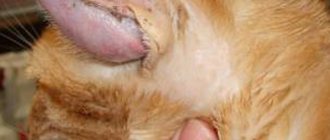Routes of infection
The papilloma virus is most often transmitted from a sick animal to a healthy one through direct contact. Pets often become infected during mating. Therefore, before mating, it is necessary to check the cat and the female cat for the presence of papillomatosis.
However, sexual intercourse is not the only method of infection. Animals become infected through any bodily contact with a sick relative, for example during play or mutual licking. The papilloma virus can live for some time in the external environment. In rare cases, infection occurs when sharing a bowl or tray with a sick animal.
However, warts do not always appear on the skin and mucous membranes when infected. Many cats are carriers of the causative agent of papillomatosis, but are absolutely healthy. This virus is considered an opportunistic pathogen. It lives in the body of many animals, but is activated and becomes pathogenic only under unfavorable conditions. Papillomas in cats occur when immunity decreases. The appearance of warts indicates that your pet is very weakened.
Removal of papillomas from a cat under local anesthesia
What are papillomas in cats and why do they appear? This disease is quite widespread among both animals and people. Why papillomas appear, how dangerous they are, and how to treat them - this is what our article is about today.
If your pussy has symptoms of illness, then do not waste valuable time, contact the Center for Emergency Veterinary Care for Animals “YA-VET”.
Veterinarians with a high level of education, training and many years of experience are at your service. Diagnostics are carried out using the latest generation equipment and with a very high degree of accuracy.
It is also possible to call a veterinarian to your home, where they will conduct an examination and make a diagnosis in a calm and familiar environment for the animal. To call for emergency veterinary help, call the phone and a doctor will be with your pet in the shortest possible time.
Papillomas in cats: etiology and pathogenesis of the disease
Among the representatives of domestic cats there are animals that suffer from a dangerous disease of an infectious nature. We are talking about feline viral papillomatosis .
The disease described is a fairly dangerous disease and is characterized by the fact that infected cats have focal lesions, both single and multiple. They are benign neoplasms.
In appearance, they resemble warts and are localized both on the skin and on the mucous membranes in the mouths of cats and in other places with a mucous membrane. Papillomas are often found on the skin of cats.
Speaking about the reasons that result in the appearance
of papillomas in cats (and in cats and even kittens), you should immediately pay attention to the strong decrease in immunity.
This happens after operations, as well as as a result of serious illnesses, after giving birth to cats, or during treatment with certain medications.
It is impossible to exclude the age factor, as well as the genetic hereditary predisposition of the animal.
Sexual transmission of the papilloma virus has been proven
and because of this, papillomatosis can be considered a sexually transmitted disease.
- Being in a latent state in the body,
papillomatosis virus can be activated when
- :
- suffered under severe stress;
- after viral infections.
The papilloma virus in cats penetrates into the cells of the basal layer of the skin through injuries, scratches, abrasions and cuts. Actively multiplying, the virus grows on the surface epidermis or on the surface of the mucous membrane.
Under the direct influence of the transforming proteins of the virus, the affected cells begin to divide and multiply without limit. That is, they develop a tumor structure.
At their core, papillomas are benign tumors. However, if you tear off a papilloma, its cells begin to divide non-stop. Papilloma turns into cancer, that is, into cancer.
However, often there is both a spontaneous recovery of the animal and the degeneration of papillomas into malignant tumors, which lead to the death of the cat.
Symptoms of papilloma disease in cats and diagnostic methods
A characteristic symptom of the lesion is the formation of multiple lesions and the rapid rate of their growth.
Having a pale pink color and a very small size in the initial stage of their development, such rashes can go unnoticed until they are traumatically damaged. In such cases, the cat may develop significant bleeding, since the papillomas are abundantly penetrated by the capillary network.
If the papilloma is torn off, this can be the starting point for the development of skin cancer. Therefore, papilloma in a cat is a serious and quite insidious disease.
Over time, wart rashes grow, their surface acquires uneven outlines like a cauliflower. The number of papillomas is growing rapidly.
If papillomas develop in a cat's mouth, they grow along the surface of the gums, tongue, inner surface of the cheeks and under the tongue. In the most advanced cases, such growths disrupt the process of eating and chewing in cats.
Sometimes inexperienced owners suspect that the cat has a salivary gland cyst. However, the further course of the disease completely refutes this misconception.
- Symptoms of papillomatosis also include such general somatic manifestations as:
- Increased body temperature.
- Refusal of food.
- Vomit.
- Bleeding in the mouth.
- Apathy and indifferent behavior.
If there are growths on the paws, they are constantly injured. This makes it easier for pathogens to enter the cat's body. And since the animal’s immunity is noticeably reduced, secondary infectious processes develop.
Therefore, if possible, you should try not to tear off the papilloma.
Diagnostic procedures consist of an examination of the cat by a veterinarian and a detailed questioning of the owner about any visible symptoms of the disease.
- It is mandatory to carry out such
laboratory tests for diagnosis
- , How:
- General blood analysis.
- Polymerase chain reaction.
- Microscopic examination of scrapings.
- Histological studies of papillomas tissue samples.
All of the above studies are available for carrying out at the Center for Emergency Veterinary Care for Animals and by calling a veterinary specialist “YA-VET” to your home.
Treatment of papilloma in cats and prevention of the disease
It has already been said that papillomas can disappear completely spontaneously. But most often, in the absence of effective treatment, the number of growths in the cat increases, and the course of the disease becomes severe. When using complex treatment methods, the number of formed papillomas is significantly reduced, and the development of new ones is inhibited.
the most optimal treatment method . This painless procedure helps remove all growths without subsequent cosmetic defects. Papillomas can also be removed using cryotherapy, that is, freezing with liquid nitrogen. Any of the removal methods leads to the recovery of the animal and does not cause any harm to its body.
In addition to removing papillomas , the animal is given immunostimulating drug therapy, and is also prescribed a course of treatment with antiviral drugs, and given multivitamin complex tablets and mineral supplements. Unfortunately, none of the treatment methods can completely eliminate the papilloma virus in cats. With the slightest weakening of the immune response, the disease may recur.
As a preventative measure, it is recommended to strengthen the body’s defenses and also avoid direct contact with carriers of the papilloma virus. There are no preventive vaccines against papillomatosis.
Source: https://ya-vet.com/hirurg/udalenie-papillom-u-koshki-ili-kota-pod-mestnoj-anesteziej
Provoking factors
The following factors can trigger the activation of the virus:
- chronic illness;
- pregnancy and feeding of kittens;
- long-term use of medications;
- stress;
- avitaminosis;
- hypothermia;
- advanced age of the animal.
Small kittens often suffer from papillomatosis. Their immunity is still poorly developed.
It is important to remember that if papillomavirus has entered an animal’s body, it remains in the cells forever. Treatment can only reduce its pathogenicity and lead to the disappearance of external manifestations of papillomatosis. After therapy, the virus will be in a “dormant” state. It can be reactivated at any time as soon as the animal’s immunity decreases.
What is the danger?
If the owner notices such formations on the animal’s paw pads, then they need to be monitored and prevented from growing. Small growths on a cat's fingertips are not particularly dangerous. If the owners notice the active growth of papillomas, then they should immediately contact a veterinarian. When the formation becomes large, the blood supply to it improves and the risk of damage increases, which will lead to severe bleeding. Anemia develops against the background of large blood loss, and if a similar complication occurs in a kitten, it may die. There are other negative consequences for papillomas in cats:
- Inflammatory reaction. Violation is possible with minor or significant damage to the neoplasm.
- Cancer development. Although papillomas are benign growths, under the influence of certain factors they can degenerate into malignant formations.
Can a person get infected from a cat?
Should you be careful when handling a sick animal? After all, it is known that papillomatosis affects not only cats, but also people. However, the animal owner has no reason to fear. After all, warts in people occur due to infection with the human papillomavirus (HPV). In cats, skin lesions are caused by a completely different pathogen. People with papillomatosis also cannot transmit the virus to animals. HPV is specific to humans only. A sick cat cannot infect a dog. She is dangerous only for her relatives. Therefore, you should limit her contacts with other cats, especially with small cubs.
Symptoms and types of papillomas
What do papillomas look like in cats? Warts are growths on the skin. They can fit tightly to the epidermis or rest on a stalk. The color of the growths can vary from flesh-colored to yellow or dark brown. The size of warts can range from 4 mm to 1 cm. In severe cases, papillomas merge and form growths similar to a head of cauliflower. A photo of papilloma in a cat can be seen below.
This viral infection is accompanied not only by the appearance of warts. Other signs of the disease are also noted:
- loss of appetite;
- lethargy, apathy;
- skin itching in the area of the rash;
- ulcers at the site of torn warts.
A general deterioration in health occurs more often in small kittens. Papillomatosis can be difficult for pups to tolerate.
Rashes can be localized in different areas of the skin and mucous membranes. Papilloma on the ear in cats most often occurs due to tick-borne infestation - otodectosis. In this case, the appearance of warts is accompanied by severe inflammation and itching in the ear. This combined disease requires persistent and long-term treatment.
Papilloma in a cat's nose can cause pain. After all, the animal’s nostrils are very sensitive. A large wart in the nasal passage can significantly complicate breathing.
Probable locations of papillomas on the body
Characteristic symptoms of infectious papillomatosis are the occurrence of focal lesions on the mucous membranes of the mouth, the formation of pathogenic neoplasms on the outer surface of the tongue and lips. The disease is progressive and over time, papillomas can appear on the palate, pharyngeal mucosa, and nose.
At the initial phase of appearance, papules have a smooth structure. Over time, the number of lesions increases, uneven growth of the mucous membrane occurs, which provokes changes in the appearance and structure of papillomas. The number of papillomas gradually increases; in severe cases, they can cover the cheeks, gums, and can appear in the ears, on the paws, on the head, near the urethra, on the gastrointestinal tract, on the eyelids, and on the conjunctiva of infected animals.
Papillomas in the mouth cause discomfort when eating food; sick individuals may experience fever, excessive salivation, refusal to feed, bleeding in the mouth, and attacks of vomiting.
Neoplasms on the paws and ears can provoke serious inflammatory lesions, since the limbs are constantly in contact with the surface of the floor or ground, and there is a danger of ticks in the ears.
The external genitalia can also be affected; painful wounds and nodular formations are often observed here.
How to distinguish a wart from a tick
During a walk, a cat may be attacked by ixodid ticks. These parasites are carriers of serious diseases that are dangerous to both animals and people.
How to determine: a tick on a cat or papilloma? Large grayish warts may resemble parasites in appearance. You need to take a close look at the formation on the animal’s skin. If necessary, use a magnifying glass. If there are legs around the “wart”, then it is an ixodid tick.
In addition, papillomas grow slowly, and the tick, having sucked blood, quickly increases in size. However, in such cases, you cannot passively watch the growth of a strange growth on the skin. The parasite must be immediately removed from the pet's body, otherwise the cat may become infected with dangerous infections. Therefore, if you have any doubts, you should immediately contact a veterinary clinic.
Diagnostics
Single or multiple warty growths found on the skin or mucous membranes of a cat can be of different nature. To make a diagnosis of papillomatosis, a laboratory examination of a fragment of a neoplasm taken during a biopsy using immunohistochemical staining and electron microscopy is performed. The cat is also given a blood test to check for Papillomaviridae virus DNA. The most reliable method is PCR using polymerase chain reaction, which allows detecting the virus even in a latent form.
Possible complications
As already mentioned, warts in animals can lead to serious consequences. Papillomatosis is often accompanied by itching. Animals scratch the affected areas and tear off tumors. Bleeding ulcers appear on the skin. This can lead to malignant cell degeneration and skin cancer.
Oncological diseases are the most dangerous, but far from the only complication of papillomatosis. When large warts are injured, severe bleeding may occur, leading to anemia. Also, sores and scratches can become infected and fester.
Characteristic symptoms
The appearance of such formations on the body of a fluffy can affect the quality of his appetite. Papilloma can form on the paws, stomach and any other parts of the body, including on the pad of a cat’s finger. In some pets, the formation looks like an ordinary mole; in other animals, there may be a growth that rises greatly above the skin and can cause discomfort to the cat. Alarming symptoms and pathological growths appear immediately after infection with weak immunity or after 2 months. When a cat has a wart, the following signs are additionally recorded:
- problems with appetite or complete refusal to eat;
- indifferent attitude towards everything;
- the appearance of papillomas of different locations and sizes;
- itchy sensations.
With papillomatosis, owners should monitor the cat so that he does not scratch problem areas, since open wounds will soon appear, which can become infected, and the disease will become more complicated.
Treatment
For the treatment of papillomas, immunomodulators and vitamins are prescribed:
- "Vitafel";
- "Gamavit";
- "Maksidin";
- "Ascorbic acid" (injections).
Drugs are also used for symptomatic treatment. In case of severe itching, the animal is recommended to take Suprastin. If there are scratches on the skin, it is recommended to lubricate the damaged areas with antiseptic ointments and solutions:
- "Levomekolem";
- "Betadine";
- "Chlorhexidine."
Treatment with immunomodulators takes quite a long time. If the tumor grows strongly or prevents the animal from breathing and eating, then removal of the wart is indicated.
Most often, removal of papillomas in cats is carried out using Novocaine injections. Injections of the drug are prescribed intravenously or at the base of the wart. The amount of medication is calculated by the veterinarian and depends on the weight of the cat. The injections are repeated three times with an interval of 2-3 days.
Surgical treatment of papillomas in cats is carried out in the absence of effect from the use of novocaine. Warts are removed using the following means:
- liquid nitrogen;
- laser;
- ultraviolet radiation.
After removal of the tumors, it is necessary to undergo a course of treatment with immunostimulants and vitamins. This will help prevent relapses of papillomatosis.
Reasons leading to the problem
The main source of the formation of papillomas in cats on the head, bridge of the nose, fingers, paws and other areas of the body is the papillomavirus. In every pet, like in humans, a similar pathogenic microorganism is constantly present, but in the latent phase. To activate the virus and its active reproduction, the influence of the following factors is required:
- Weak immunity. For this reason, papillomas on the nose or claw often form in kittens whose immune system is not yet fully functioning. Also at risk are sick animals, cats after giving birth and pets taking medications.
- Age-related changes in the body. Old cats often develop similar moles that need to be examined by a veterinarian.
- Heredity.
- Severe stress.
- Chronic infectious diseases.
Such growths on the animal’s body are benign.
In veterinary medicine, a similar disease is also known as papillomatosis, in which small formations of a benign nature are formed. Under the influence of certain factors, papillomas in cats can degenerate into cancerous tumors, which pose a direct threat to the life of the animal. At risk of developing warts on the body are individuals living in large groups and without maintaining satisfactory sanitary and hygienic conditions. The virus is transmitted through contact of a healthy cat with a sick one, and infection is also possible through wounds on the skin. If a pregnant cat is infected with papillomavirus, then the disease is likely to be transmitted to kittens.
Traditional methods
Is it possible to treat papilloma in cats at home? You should not rely completely on folk remedies. After all, papillomatosis is a viral infection, and it is impossible to do without drug therapy. Folk remedies can be used only after consulting a specialist. They are used only in combination with veterinary drugs and sometimes with surgical treatment.
For small papillomas, the following remedies are effective:
- Iodine. This antiseptic should be applied to a cotton swab and cauterized the stem of the wart.
- Rowan. Ripe fruits are crushed to a paste and applied to papillomas twice a day.
- Celandine. You need to squeeze the juice out of the plant and treat the new growths with it.
- Acetic acid. The product is applied to a cotton swab and the papilloma is cauterized.
- Garlic. You need to squeeze the liquid out of the garlic clove and lubricate the wart.
Folk remedies are effective only for single tumors. If papillomas affect large areas of the skin, then only drug and surgical treatment can help.
Papillomas, warts in cats: what causes them, treatment, removal
What are papillomas in cats and why do they appear? This disease is quite widespread among both animals and people. Why papillomas appear, how dangerous they are, and how to treat them - this is what our article is about today.
If your pussy has symptoms of illness, then do not waste valuable time, contact the Center for Emergency Veterinary Care for Animals “YA-VET”.
Veterinarians with a high level of education, training and many years of experience are at your service. Diagnostics are carried out using the latest generation equipment and with a very high degree of accuracy.
It is also possible to call a veterinarian to your home, where they will conduct an examination and make a diagnosis in a calm and familiar environment for the animal. To call for emergency veterinary help, call the phone and a doctor will be with your pet in the shortest possible time.
Symptoms
Neoplasms in cats differ in that seals appear on the body. But it is quite difficult to notice them, since usually no one probes their animal every day.
When internal organs are damaged, significant changes in the pet’s condition are noted:
- disorders of the gastrointestinal tract;
- metabolic disorders;
- neurological symptoms;
- changes in blood composition;
- respiratory problems.
Secondary characteristics:
- ascites;
- cough;
- shortness of breath, vomiting.
If a tumor in cats forms in the skin, its growth is slow. Metastasis is observed only in late stages. When a tumor grows on the mucous membranes, it grows faster and metastasizes to the lymph nodes. Melanoma in this case is prone to bleeding.
The tumor metastasizes through the blood or lymph. Those nodes that are located close to the formation are most often affected. Metastases into the dermis may be observed; they look like small dark rashes. Metastases that are transmitted through the blood can appear in various organs. The adrenal glands, brain, and liver are most often affected.
Shortness of breath may be a visible symptom of malignancy in cats over 10 years of age.
Reviews
Animal owners leave positive reviews about the treatment of papillomatosis with novocaine injections. After 2-3 injections, the warts completely disappeared. However, cat owners emphasize that after the course of treatment it is necessary to give their pets immunomodulators. Otherwise, papillomas may grow again.
You can find positive reviews about the treatment of papillomatosis with ascorbic acid injections. Vitamin therapy helps strengthen the immune system and mobilize the body's defenses to fight the virus. However, such remedies are effective only for mild forms of the disease.
Experienced cat breeders recommend resorting to surgical methods for treating warts only in extreme cases, if the tumor prevents the animal from breathing or eating. Surgery is also necessary if there is a risk of malignant changes. This is a rather expensive procedure that is not available to all cat owners.
The pharmaceutical drug “Cryopharma” also received good reviews. It comes in aerosol form and contains a mixture of dimethyl ether and propane. This product is used to freeze and remove warts. Its action is similar to that of liquid nitrogen. However, this drug is intended for humans. Before using it on animals, you should consult your veterinarian. Only a specialist can take into account the indications and contraindications for the use of an aerosol.
Are warts dangerous?
Most veterinarians are of the opinion that warts in dogs are a phenomenon that does not require close attention. An animal with normal immunity recovers without treatment. The exception is when the dog suffers from a large number of rashes.
Photo. Papilloma on a dog's lip.
In addition, the animal can tear off the wart during scratching or other mechanical stress. In this case, there is a risk that an infection will get into the wound. The second dangerous point is the degeneration of papillomas into a cancerous tumor.
In what cases is treatment of warts necessary:
if they are located in the mouth and interfere with chewing; if warts affect the eye area; if there is a risk that the dog will injure the wart; if a malignant tumor is suspected.
Important! In any case, it is worth showing your pet to a veterinarian, since a wart can be confused with other types of skin tumors (fibroma, lipoma, melanoma, sebaceous or sweat gland adenoma)











